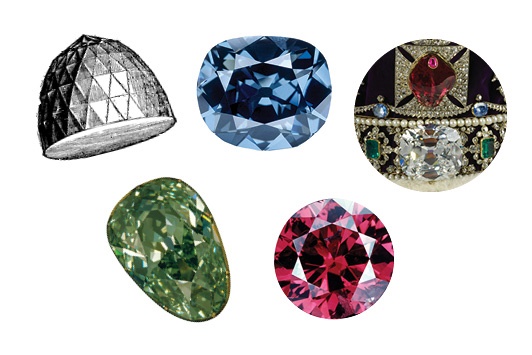|
|
GIA Librarian on Why Diamonds Make the Grade
Dec 25, 2017 9:45 AM
By Sonia Esther Soltani
|
|
|
Robert Weldon, head of the lab’s gemological library, shares his thoughts on why diamonds have stood out in different generations and cultures.
Why we love them
Diamonds help us celebrate loving and joyous
occasions — betrothals, weddings, anniversaries, births and birthdays. They can
also mark a moment of self-fulfillment and accomplishment. Once the purview of
the ultra-wealthy or royalty, diamonds have been democratized. Diamonds are
unexpected gems. Though it’s extremely rare, diamonds can be red, orange,
yellow, green, blue, grey, violet — with hundreds of variations in between.

A history of symbolism
Diamonds have been appreciated for thousands
of years. They were believed to imbue the wearer with the gems’ own
characteristics. In India, people who wore diamonds were assured of having a
long life, physical endurance, and beauty. Perhaps because of this, diamonds
remain a symbol of love in many societies around the world.
In a class by themselves
Rarity, hardness, brilliance and scintillation
are all aspects that we appreciate in diamonds.... Other gems are appreciated
for different reasons, but principally for their depth of color. For example,
the rarity and beauty of rubies, emeralds and sapphires are also remarkable
attributes.
Iconic examples
Different people will have varying opinions,
but I believe these five diamonds stand out for their unique history, their
iconic status, their singular size or color, and for the people who loved them:
The Great Mogul, Hope Diamond, Cullinan, Dresden Green and Hancock Red.
Fascinating facts
While we know about the hardness — 10 on the
Mohs hardness scale — many people do not realize that diamonds are also great
conductors of heat. This allows them to be used in tooling, such as cutting,
grinding and drilling, where extreme heat or pressure will not cause them to
disintegrate. Diamond powder is successfully used to preform and polish other
colored gemstones.
Personal meaning
Aside from their beauty and reflective
characteristics, I am awed by a diamond’s sense of permanence. Diamonds can be
passed on to family members for generations, and by this simple act, family
history is conveyed with the glittering gem. This is how people’s relationship
with diamonds is constantly reaffirmed.
The five most iconic diamonds, in the
words of the GIA’s top librarian:
 The Great Mogul. This is a 280-carat gem — roughly the size of an “egg cut in half.”
This was the description by the great French traveler and gem merchant
Jean-Baptiste Tavernier. He saw it and described it in his books when it was in
the possession of [17th-century Mughal emperor] Shah Jahan. He was told that
the original weight of this diamond from Golconda, India, was 787.50 carats. The Great Mogul. This is a 280-carat gem — roughly the size of an “egg cut in half.”
This was the description by the great French traveler and gem merchant
Jean-Baptiste Tavernier. He saw it and described it in his books when it was in
the possession of [17th-century Mughal emperor] Shah Jahan. He was told that
the original weight of this diamond from Golconda, India, was 787.50 carats.
The Hope Diamond. This is also an old Golconda diamond that has passed through many
hands, including Tavernier’s. He sold the stone to Louis XIV of France in 1668.
The diamond has a remarkably storied history. I did have a chance to photograph
the 45.52-carat [stone] once — just five minutes were allowed for me to peer
into its depths. I got chills knowing I was in the presence of one of the
world’s most famous diamonds.
Cullinan I, II. When it was found in 1905 in South Africa, the rough weighed 3,025.75
carats — the biggest diamond found. It was cleaved and cut, and its major and
satellite diamonds were set into the most significant jeweled objects in
history: the Crown Jewels of the United Kingdom.
The Dresden Green. This modified pear shape is an approximately 41-carat gem, unique in
that it is a confirmed naturally green diamond.
Hancock Red. This is a fairly modern diamond, an unassuming round brilliant-cut
weighing less than 1 carat. What makes this diamond special is the depth of its
red color. Its record-shattering sale at Christie’s in 1987 (with a per-carat
price of $926,000) changed the world’s appreciation for fancy colored diamonds.
The GIA graded this diamond in 1956.
Images: Judy Colbert/GIA; GIA; Alamy Stock Photo
This article was first published in the December 2017 issue of Rapaport Magazine.
|
|
|
|
|
|
|
|
|
|
Tags:
GIA, Robert Weldon, Sonia Esther Soltani , Sonia Esther Soltani. famous diamonds
|
|
Similar Articles
|
A piece of the auction
|
|
Nov 03, 2022
|
|
Prernaa Makhariaa Jewelry blogger and influencer There are many unique diamonds and jewelry pieces
|
|
|
|
A push to do better
|
|
Oct 31, 2022
|
|
Christina Miller has dedicated her working life to changing the way people think. After training
|
|
|
|
|
|
|
|
|
|
|

|
|